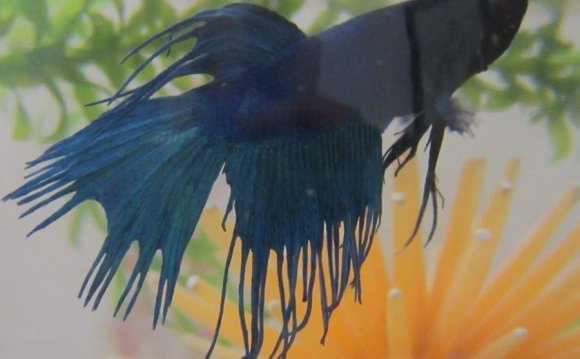
|
OK, let’s take a tour of Mr. Betta’s body: The above is a rough map of Mr. Betta's attributes. But now let us get a more in depth look. Come closer. Cloooooser... Don't worry, he's not going to bite. Or is he? The mouth Every time I look closely at a betta’s face, I think of bulldogs. Of course bettas are prettier, but still, their jaw is proportionally just as impressive. The lower jaw is powerful and will shred any live worms, mosquito larva, brine shrimp, etc… The mouth is perfectly designed and positioned to devour as well as to blow bubbles, which, as you all know by now, is two of Mr. Betta’s favorite pass times. :) Bettas are voracious and if you ever try to stick your whole arm in a 60 gal tank filled with adult bettas, you will know just what I mean. AOUTCH! Those guys keep biting the inside of my arm and it hurts! Like needles. Used to make it hard for me to care for my live plants. I have nicknamed them “my little piranhas” hehehehe. The same jaws can do wonders on another betta’s fins. One of my females once SHREDDED a gorgeous DT male to the point where he had no fins left. He looked like a female!! I was told by the Animal Planet crew that proprotionally, bettas had bigger and stronger jaws than... JAWS himself. Watch out great white sharks, here comes the bettas! It's a good thing bettas are small, cause on a larger scale they would be quite a handful! The might is lined with pointy teeth that work kinda like a paper shredder: CHOMP CHOMP CHOMP. When bettas latch on to each other's fins they do not let go. Actually the fins will tear and the aggressor usually leaves the scene with a nice chunk of fin in his mouth, which he then proceeds to promptly gobble up (remember what I said? Fighting and eating are their favorite pass times LOL). But there is more to the mouth than meet the eyes. Beyond that intimidating row of sharp teeth, lays a warm, safe place for the fry. For the bettas will carry their young inside that same mouth formerly used to chew up their food and rivals. How such an aggressive fighter can be such a gentle parent is always a sort of amazement to me. How can a male catch his falling fry in his mouth and then gently take them back to the nest and spit them out, alive and well, without harming them? Ahhhhh... The wonders of mother nature. What's most, how come the fry don't get stuck between his teeth? I always wondered about that, until the day I caught a betta (late at night) discretely flossing ;P. Because bettas floss on a regular basis, they never get cavities. Hence you will not have to worry about ever having to take your betta to the dentist LOL. So bettas are a low maintenance pet. (I think I need a vacation)... OK so maybe the part about flossing was not exactly true, but everything else up and until that point is. I promise :). Wait. There is more. Let us in passing mention a few other items located near the mouth. On each side of the head, you will locate one bulging eye. The head has two sides, so (let me see if my calculations are correct) that would mean that the betta has 1+1 ab2 - cd3 + (34/56) = 2. Yes, that seems about right. Two eyes it is. The eyes are protruding and the iris is usually black, while the rest of the eye can be of different color. From snow white to jet black. Bettas can move their eyes to follow a moving object. They are also rather curious about their surroundings and will check out anything new you add to their tanks with much interest. One problem bettas have: They cannot blink. This makes courtship between the male and female especially tricky, for the male cannot blink to the female to indicate that he thinks she is HOT. Also, bettas are not very good whistlers. I think that is why they had to come up with another way to show their belle that they are crazy about her: That's where the whole flaring thing comes in. The 'beard' Another interest trait of Mr. Betta is the presence of a membrane under the gill plate covers. Females have a smaller version of it, but in the male it is large enough to actually kinda “stick out” when the gill plate are closed. This membrane can be of various coloration, depending on the betta color. Generally, in bettas of dark color, blues and red, the membrane will be dark. But with light colored bettas, it will often have the same color as the body (yellow, white, clear, etc…). Marbles can be interesting as the membrane can also be marbled. What use is this membrane you ask? OK, OK I’m getting there, don’t be impatient! :)
If you look once again at the above photo (cool angle, you got to admit) you will clearly see the membrane but you will also see the gills of the betta. I must point this out to you because here lays one of Mr. Bettas most interesting, most useful and most fascinating attribute: The labyrinth.
Source: www.bettatalk.com
Share this Post |









